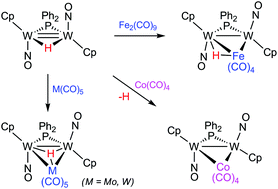当前位置:
X-MOL 学术
›
Dalton Trans.
›
论文详情
Our official English website, www.x-mol.net, welcomes your
feedback! (Note: you will need to create a separate account there.)
Structure and dynamics of heterometallic clusters derived from addition of metal carbonyl fragments to the unsaturated hydride [W2Cp2(μ-H)(μ-PPh2)(NO)2]
Dalton Transactions ( IF 3.5 ) Pub Date : 2017-10-25 00:00:00 , DOI: 10.1039/c7dt03580b M. Angeles Alvarez 1, 2, 3, 4 , M. Esther García 1, 2, 3, 4 , Daniel García-Vivó 1, 2, 3, 4 , Miguel A. Ruiz 1, 2, 3, 4 , Adrián Toyos 1, 2, 3, 4
Dalton Transactions ( IF 3.5 ) Pub Date : 2017-10-25 00:00:00 , DOI: 10.1039/c7dt03580b M. Angeles Alvarez 1, 2, 3, 4 , M. Esther García 1, 2, 3, 4 , Daniel García-Vivó 1, 2, 3, 4 , Miguel A. Ruiz 1, 2, 3, 4 , Adrián Toyos 1, 2, 3, 4
Affiliation

|
The title complex reacted with [Fe2(CO)9] to give the trinuclear derivative [FeW2Cp2(μ-H)(μ-PPh2)(CO)4(NO)2] (W–W = 3.044(1) Å) as a result of full insertion of the 16-electron Fe(CO)4 fragment into the tricentric W–H–W bond of the parent substrate. In contrast, the reactions with the THF adducts [M(CO)5(THF)] (M = W, Mo) and [MnCp′(CO)2(THF)] (Cp′ = C5H4Me) yielded the μ3-hydride derivatives [MW2Cp2(μ3-H)(μ-PPh2)(CO)5(NO)2] (W–W = 3.006(1) to 3.164(1) Å for the W3 compound) and [MnW2Cp2Cp′(μ3-H)(μ-PPh2)(CO)2(NO)2] respectively, all of them resulting from addition (rather than insertion) of the corresponding 16-electron fragment to the W2H moiety of the parent compound. Density Functional Theory calculations revealed that edge- and face-bridged hydride clusters were of similar energy in the W2Fe system, while the face-bridged structure was significantly more stable (by more than ca. 40 kJ mol−1) for the W3 system. Both clusters displayed fast rearrangement in solution involving a flapping movement of the puckered PW2M core of these molecules. This was combined, in the W2Fe cluster, with fast exchange between the almost isoenergetic edge- and face-bridged hydride isomers. The reactions of the title compound with several carbonyl dimers were also examined as an additional synthetic approach to the rational synthesis of heterometallic clusters, but were unsuccessful except in the case of [Co2(CO)8], which reacted at 253 K in the dark to give a mixture of the binuclear complex [CoWCp(μ-PPh2)(CO)4(NO)] (Co–W = 2.8623(6) Å) and the trinuclear cluster [CoW2Cp2(μ-PPh2)(CO)4(NO)2] (W–W = 3.1654(4) Å; W–Co = 2.638(1), 2.829(1) Å), the latter resulting from formal replacement of the hydride ligand with the 17-electron fragment Co(CO)4, which displayed an asymmetric binding to the W2 centre.
中文翻译:

结构,并从另外的金属羰基片段与不饱和的氢化衍生的异金属簇的动力学[W 2的Cp 2(μ-H)(μ-PPH 2)(NO)2 ]
标题复用的[Fe反应2(CO)9 ],得到三核衍生物[FEW 2的Cp 2(μ-H)(μ-PPH 2)(CO)4(NO)2 ](W-W = 3.044( 1)Å)是将16电子Fe(CO)4片段完全插入母体底物的三中心W–H–W键中的结果。相反,与THF加合物[M(CO)5(THF)](M = W,Mo)和[MnCp'(CO)2(THF)](Cp'= C 5 H 4 Me)的反应产生μ 3个-hydride衍生物[MW 2的Cp 2(μ 3 -H)(μ-PPH 2)(CO)5(NO)2 ](W-W = 3.006(1)〜3.164(1)一种用于W 3化合物)和[MNW 2的Cp 2 CP'(μ 3 -H)(μ-PPH 2)(CO)2(NO)2 ],它们都是由相应的16电子片段加成(而不是插入)到母体化合物的W 2 H部分中而产生的。密度泛函理论的计算表明,在W 2 Fe系统中,边缘桥联和面桥联的氢化物簇具有相似的能量,而W的面桥结构明显更稳定(约大于40 kJ mol -1)。3系统。两个簇在溶液中均显示出快速的重排,涉及这些分子的皱纹的PW 2 M核的扑动。在W 2 Fe团簇中,这与几乎等能量的边缘和面桥氢化物异构体之间的快速交换结合在一起。还检查了标题化合物与几个羰基二聚体的反应,作为合理合成杂金属簇的另一种合成方法,但除[Co 2(CO) 8 ]的反应在253 K下于253 K反应外,均未成功。暗,得到双核络合物[CoWCp(μ-PPH的混合物2)(CO) 4(NO)](全体= 2.8623(6))和三核簇[CoW的2的Cp 2(μ-PPH 2)(CO)4(NO)2 ](W-W = 3.1654(4); W-CO = 2.638(1),2.829(1)),后者从正规更换所得氢化物配体具有17个电子片段Co(CO)4,该片段显示出与W 2中心的不对称结合。
更新日期:2017-11-15
中文翻译:

结构,并从另外的金属羰基片段与不饱和的氢化衍生的异金属簇的动力学[W 2的Cp 2(μ-H)(μ-PPH 2)(NO)2 ]
标题复用的[Fe反应2(CO)9 ],得到三核衍生物[FEW 2的Cp 2(μ-H)(μ-PPH 2)(CO)4(NO)2 ](W-W = 3.044( 1)Å)是将16电子Fe(CO)4片段完全插入母体底物的三中心W–H–W键中的结果。相反,与THF加合物[M(CO)5(THF)](M = W,Mo)和[MnCp'(CO)2(THF)](Cp'= C 5 H 4 Me)的反应产生μ 3个-hydride衍生物[MW 2的Cp 2(μ 3 -H)(μ-PPH 2)(CO)5(NO)2 ](W-W = 3.006(1)〜3.164(1)一种用于W 3化合物)和[MNW 2的Cp 2 CP'(μ 3 -H)(μ-PPH 2)(CO)2(NO)2 ],它们都是由相应的16电子片段加成(而不是插入)到母体化合物的W 2 H部分中而产生的。密度泛函理论的计算表明,在W 2 Fe系统中,边缘桥联和面桥联的氢化物簇具有相似的能量,而W的面桥结构明显更稳定(约大于40 kJ mol -1)。3系统。两个簇在溶液中均显示出快速的重排,涉及这些分子的皱纹的PW 2 M核的扑动。在W 2 Fe团簇中,这与几乎等能量的边缘和面桥氢化物异构体之间的快速交换结合在一起。还检查了标题化合物与几个羰基二聚体的反应,作为合理合成杂金属簇的另一种合成方法,但除[Co 2(CO) 8 ]的反应在253 K下于253 K反应外,均未成功。暗,得到双核络合物[CoWCp(μ-PPH的混合物2)(CO) 4(NO)](全体= 2.8623(6))和三核簇[CoW的2的Cp 2(μ-PPH 2)(CO)4(NO)2 ](W-W = 3.1654(4); W-CO = 2.638(1),2.829(1)),后者从正规更换所得氢化物配体具有17个电子片段Co(CO)4,该片段显示出与W 2中心的不对称结合。











































 京公网安备 11010802027423号
京公网安备 11010802027423号